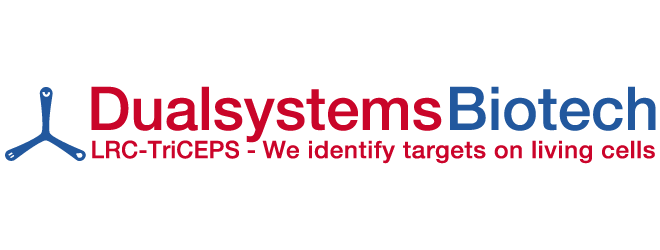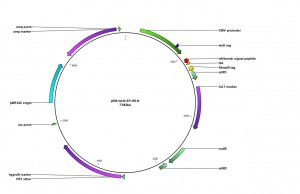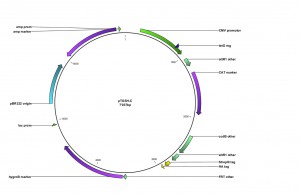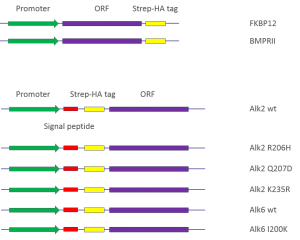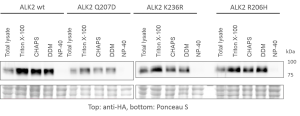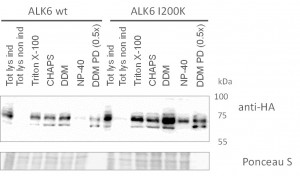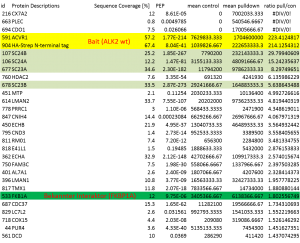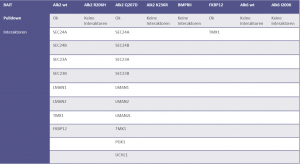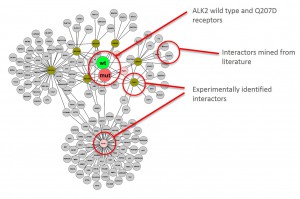Investigation of ALK2 interactions in Hek293 cells
The following BMP4 signal cascade components were chosen for investigation:
- ALK2 wild type receptor
- ALK2 mutated receptors:
R206H (causes FOP (Fibrodysplasia ossificans progressiva))
Q207D (constitutive active)
K235R (dominant negative) - ALK6 wild type receptor
- ALK6 mutated receptor (I200K): causes brachydactyl (shortness of the fingers and toes)
- BMPRII: type II receptor
- FKBP12
Construction of novel expression vectors
Novel expression/purification vectors were generated to stably express the selected baits:
- Strep II and HA epitope tags for detection and purification
- Inducible tet promoter for regulated expression
- Selection marker for stable cell line generation
An additional expressionvector was constructedfortheexpressionof type I integral membraneproteinscarrying a cleavable N-terminal signalsequence:
Expression constructs
Transfection and establishment of stable Hek293 cells
- Hek293 cells were transfected with the following constructs using the CaPo method:
ALK2wt (wild type)
ALK2 Q207D
ALK2 K236R
ALK2 R206H - Stable lines were selected using hygromycine
- Expressed bait proteins were detected by Western blotting using an antibody against the HA tag
- Extraction and purification were optimized using different detergent mixes to ensure optimal recovery of transmembrane receptors
- Establishment of 8 stable Hek293 lines expressing key components of the BMP signaling cascade
- Optimization of purification procedure to ensure reproducible capture of interactors
- Western blots of representative purifications are shown below
- Optimization of purification procedure to ensure reproducible capture of interactors
- Western blots comparing purification of ALK6 wild type (wt) and I200K mutant under different conditions from stable Hek293 lines
Assessing the BMP signaling pathway in stable Hek293 lines
- Stable Hek293 lines were stimulated with the ligand BMP4 for 30 mins
- Phosphorylation of Smad proteins was assessed using a phospho-specific antibody at the indicated time points
- Stimulation was compared across the ALK2 wild type and mutant receptors
- „Tet“ indicates whether expression of the receptor was induced by tetracycline (+) or whether uninduced cells were used (-)
Purification of receptor complexes from stable Hek293 lines
- Protein complexes around the bait proteins were purified from stable Hek293 lines using the optimized large scale affinity purification procedure
- All purifications were carried out in triplicate using the Strep tag fused to the baits
- Purified protein complexes were digested with trypsin and peptides were subjected to Nano-LC separation, followed by tandem mass spectrometry analysis on a LTQ Orbitrap
- Triplicate datasets were analyzed using a custom bioinformatics pipeline and interaction networks were generated using the software Cytoscape
Example of an interactor list generated from a purification of ALK2 wt
Summary of purifications carried out on 8 stable Hek293 lines
Identifiedinteractorsarelisted in thetablebelow
- ALK2 wild type purifications yielded several known and novel interactors
- ALK2 Q207D purifications yielded several interactors which overlap substantially with ALK2 wild type interactors
- No interactions were identified for ALK2 R206H and K236R, or the BMPRII and ALK6 receptors
- FKBP12 purifications yielded one novel interactor, TMX1
- Interactors identified for ALK2 are mostly components involved in receptor sorting, turnover and receptor internalization
Graphical representation of ALK2 interactions in Hek293 cells
